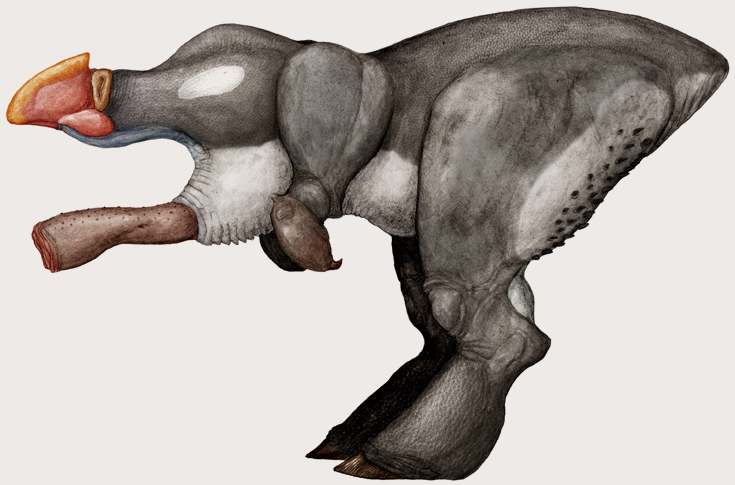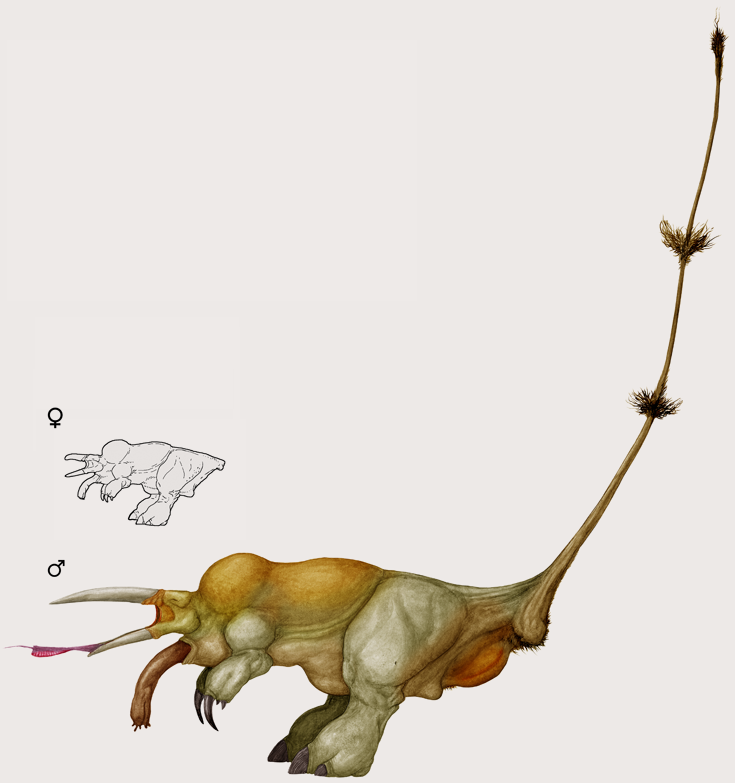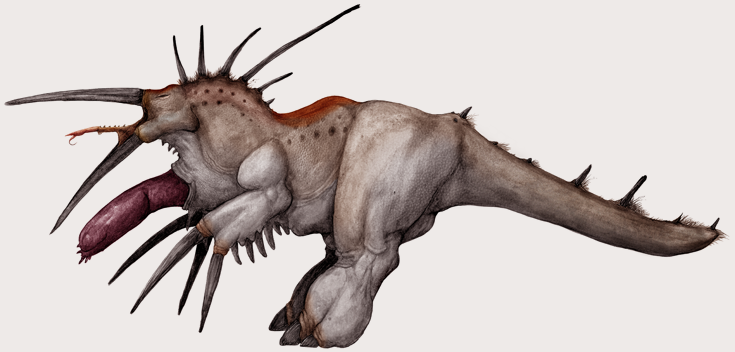Heterostomes
The second heads of Snaiad animals are complex structures that are specialized to gather and digest food. In many animals including the predatory lineages and some of the “simpler” herbivores, the second heads are usually made up of a puckering opening, containing a muscular, prehensile “tongue” inside. In “advanced” herbivores, the whole second head protrudes out of the chest and is grossly modified to rip-up, chew and grind plants. In the Heterostomes, however, the “tongue” has assumed the function of the entire second head of the “advanced” herbivores and boasts gripping edges, muscular ridges and movable flaps capable of “chewing” action. These creatures feed as more advanced herbivores do, although the tongue has to be retracted every few minutes to pass its contents to the real digestive section inside.
There are only three known genera of Heterostome herbivores on Snaiad, with perhaps five species in total. All of them are very specialized and phylogenically distant, hinting that they might be the last survivors of a much larger dynasty. More recently, fossils of wonderfully diverse Heterostomes have been recovered from the strata of Snaiad, lending weight to this theory. The demise of the Heterostomes was probably brought upon by the competitive pressure of advanced herbivores, as well as the dangers posed by new, efficient killers like Fututors and Kahydrons.

Species: Eubipes bicolor
Common Name: Orca Runner.
Size: Stands about 2-3 meters tall from the ground to the hip, body about 2-3.5 meters long.
Habitat: Notorian plains and sprogland, substantial introduced colonies exist around the Neomediterranean.
Used widely as a draught animal and steed during the early years of Snaiadi settlement, this is one of the most familiar beasts on the planet. Even today, when technology has made work and travel easier, people enjoy riding Orca Runners for sport. As a result, Orca Runners have spread widely around the Neomediterranean basin, existing in feral as well as captive herds. Back home in Notor, Orca Runners roam the boundaries between sprogland, forest and Erythrophyte scrubland, feeding mostly on tall bushes and low-growing trees. Unlike most other sprogland herbivores, they do not feed on sprog itself and have a more selective, but adaptable diet. Orca Runners are gregarious herd animals, usually darkening the plains with their numbers in their home range. They defend themselves against predators such as Notorian Rapists (Fututor notoriensis,) and Dromokahydrons (Xenodromos princeps,) with their strong kicks and the tough, bark-like skin surrounding their hips.
Orca Runners were domesticated through the efforts of Milassis Erdem, who in the initial years of settlement on Snaiad, initiated a program to domesticate local animals for work in the absence of industries capable of producing or growing heavy machinery. Many creatures from all around the planet were experimented with, ranging from mighty Allotaurs to Pneumagazelles, their relatives and even certain Kahydronts. In the end, beasts from the mainland continents proved to be too aggressive to tame or difficult to raise, probably due to the heightened evolutionary “arms race” going on in their ecosystems. Evolved in the relatively calmer isolation of Glacia-Notor, the Orca Runners turned out to be the ideal candidates.

Species: Thaumataurus macrurus
Common Name: Pole-wagger, Goldenhump, Thaumataur.
Size: About 2 meters long, tail stalk up to three times body length in males.
Habitat: Plateau scrublands in the southern tip of Vesterna.
The mixed green and red scrublands along certain Vesternian highlands are occasionally punctuated with the impossibly long, waving tail stalks of these strange herbivores. Results of and ancient sexual armaments race, these bizarre structures sometimes grow as tall as electric poles. The males who possess them face each other in spectacular ritual fights, but the erect structures flag out their territories even when they are browsing or idling. This naturally makes them very conspicuous to predators as well, so accidents, male-to-male fights and attacks cause most of them to lose their tails soon after the mating season. A higher number of males do end up getting killed by predators during this time, but the risk caused by predation is evidentially worth taking in order to father the next generation. Thaumataur females lack the long beaks, extravagant colors and the characteristic tail stalks of their male counterparts. They live in closely-knit, harem-style groups, usually dominated by a single male until he dies, or a challenger takes his place.
Thaumataurus belongs to a lineage of Heterostomes that used to have many lightly built, running species roaming across Snaiad. Fossil discoveries reveal that the exaggerated tail stalks of male Thaumataurs had their ancestry in the stiff, counterbalancing rods of their running precursors. For some reason, the line that led to today’s Thaumataurs settled down for a more sluggish browsing lifestyle while their swift-footed ancestors and relatives died out.

Species: Spinodesmus avancna
Common Name: Spiny.
Size: Up to 4 meters long from snout to tail.
Habitat: Found exclusively on the high Pontic Alps, related species occur on the Lower Pontic Alps and the Sovan Range.
The windy crags of the Pontic Alps conceal one of Snaiad’s most spectacular animals. With their foreclaws, first-head beaks, dorsal and ventral ridges all exaggerated into long, stick-like series of spikes, Spinies resemble living targets that have been used for archery and javelin practice. The lives of these creatures are notoriously difficult to observe due to the fact that they are sparsely distributed over their limited range, and in any case are extremely shy. They are more often known to visitors through the haunting sounds they produce by rattling their myriad spikes against each other. This eerie rattle is also accompanied by a very low, stereo wailing sound they make from their breathing orifices which lie, like most Snaiadi terrestrial “vertebrates,” in their armpits. Because of their elusive nature, it has been difficult to ascertain exactly how many species of Spinies there are, with separate populations on nearby mountain plains being classified as different species under the genus Spinodesmus. A distinct population of large bodied, black animals that lives in the same area as S. avancna might soon be classified as yet another species. Regardless of how many there are, all Spinodesmus species feed on a select range of mountain vegetation, and females apparently have a single offspring every year. Both sexes bear the impressive set of spines.
Spinodesmus avancna was named in the honor of Stanton Fink, one of the first explorers of the Pontic Alps and the surrounding forests. The local town of Samasti has recently adopted this creature as her mascot and proudly displays its imagery on her flag.
Copyright laws protect all intellectual property associated with Snaiad.
All artwork, concepts and names associated with this project belong to C. M. Kosemen, unless otherwise stated.
